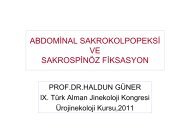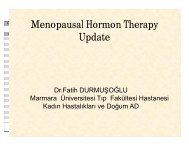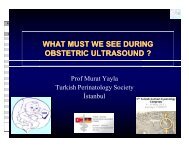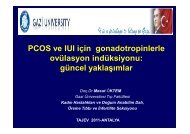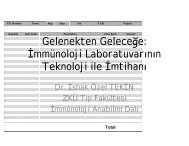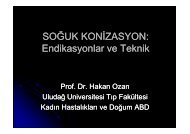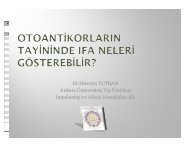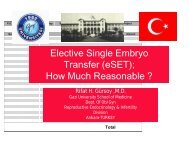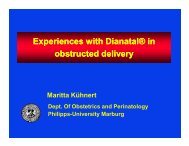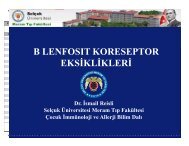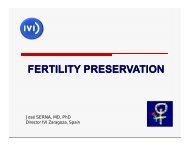Motti Goldenberg_New horizons in hysteroscopy.ppt [Uyumluluk ...
Motti Goldenberg_New horizons in hysteroscopy.ppt [Uyumluluk ...
Motti Goldenberg_New horizons in hysteroscopy.ppt [Uyumluluk ...
- No tags were found...
You also want an ePaper? Increase the reach of your titles
YUMPU automatically turns print PDFs into web optimized ePapers that Google loves.
P.O. Number Terms Rep Ship Via F.O.B. ProjectQuantity Item Code Description Price Each AmountNEW HORIZONS INHYSTEROSCOPIC SURGERYM. <strong>Goldenberg</strong>, MDSheba Medical CenterTel-Hashomer, IsraelTotal
•TheHysteroscopic Management ofIntamural Fibroids•Focal Scar Ablation for the Treatment ofMenorrhagia post Cesarean Section•HysteroscopicTreatment of ResidualTrophoblastic Tissue
THE HYSTEROSCOPICMANAGEMENT OFINTRAMURAL FIBROIDS
Type 2Intra MuralType 0Type 1
•Menorrhagia•Infertility?
Do women with <strong>in</strong>tramural fibroidssuffer from decreased fertility?Can we hope to improve fertility byremov<strong>in</strong>g <strong>in</strong>tramural fibroids?AdhesionsScarred myometriumIUA
•Review of 150 papers 1990-2002•6 papers concern<strong>in</strong>g Intramural myomaswithout cavity distortion
“Intramural myomata without <strong>in</strong>tra cavitary<strong>in</strong>volvement def<strong>in</strong>itely have an impact onpregnancy outcome <strong>in</strong> assistedreproduction.Surgical removal must be consideredespecially <strong>in</strong> patients with previous failedassisted reproductive treatment."
•Hysteroscopy:• No scar (less chance of uter<strong>in</strong>e rupture)• No peritoneal adhesions• Rapid recovery• No need for C/S•Laparoscopy• One stage• Allows pelvic assessment
• MEDIA• BIPOLAR/MONOPOLAR ENERGY• SALINE vs GLYCIN• IMAGING DURING THE PROCEDURE• NONE• LAPAROSCOPY• ABDOMINAL US• VAGINAL US• RECTAL US• PRE-OPERATIVE HORMONAL TREATMENT• ONE OR TWO STEPS
• Yang JH, L<strong>in</strong> BL• J Am Assoc Gynecol Laparosc. 2001 Nov;8(4):501-5•MEASUREMENTS AND MAIN RESULTS:•Median myoma diameter 3.3 cm•Myometrial thickness between the myoma andserosa <strong>in</strong>creased gradually and significantlyBefore 6.7 mm,Dur<strong>in</strong>g 8.9 mm,Immediately after 16.1 mm (p
•One-step hysteroscopic myomectomymay be performed to remove deeply<strong>in</strong>filtrat<strong>in</strong>g submucous myomas whenmyometrial thickness at the implantationsite is as th<strong>in</strong> as 5 mm.Lower fear of perforation
• Midl<strong>in</strong>e Resection• Long Strokes, Capsule to Capsule• Collapse of lateral walls• Camera horizontal• Avoid<strong>in</strong>g the capsule• Bipolar Resectoscope• Vessel coagulation• Low pressure• Constant orientations• 3D US
Did we complete the myomectomy?Did we reach the myometrium?!
Myomas treated hysteroscopically All submucosal myomas two step procedure are considered S<strong>in</strong>gle Intramural < 5 cm that lies close tothe endometrium
Stewart KS, Evans TWBr J Obstet Gynaecol. 1975
Cecilia FabresJournal of M<strong>in</strong>imally Invasive Gynecology,2005
CharacteristicAge (yrs)Parity (no.)Previous cesarean sections (no.)Interval from last cesareansection to <strong>hysteroscopy</strong> (yrs)Mean(range)(41–29)(6–1)(6–1)(8–1)3632.753.6
MEASUREMENTS AND MAIN RESULTS: The mean number ofprevious cesarean-section deliveries was 2.75.Infertility work-up <strong>in</strong> the 11 patients revealed 9 with unknown <strong>in</strong>fertility,1 with male <strong>in</strong>fertility, and 1 with failed tubal reversal surgery. N<strong>in</strong>e ofthem became pregnant between 14- and 24-months of follow-up.Eighty-four percent of patients (20/24) rema<strong>in</strong>ed asymptomatic(without bleed<strong>in</strong>g disturbances) after surgery.CONCLUSIONS: Previous cesarean delivery scar defect may bethe cause of <strong>in</strong>termenstrual bleed<strong>in</strong>g, and it is possible that it alsomay impair fertility, but it can be successfully treated byhysteroscopic surgery.
Tahara M, Shimizu T, Shimoura H.Fertil Steril. 2006 Aug;86(2):477-9. Epub2006 Jun 12.
• We evaluated the effectiveness of comb<strong>in</strong>ed hormonaltherapy (estrogen and progesterone tablets conta<strong>in</strong><strong>in</strong>g0.5 mg of norgestrel and 0.05 mg of ethynyl estradiol) <strong>in</strong>patients with recurr<strong>in</strong>g vag<strong>in</strong>al bleed<strong>in</strong>g after cesareansection. Several cycles of the hormonal therapyelim<strong>in</strong>ated the problem of abnormal vag<strong>in</strong>al bleed<strong>in</strong>g, andthe patients were satisfied with the treatment
•48 Patients•Median 2.4 CS•All had <strong>in</strong>tramenstrual bleed<strong>in</strong>g
•All treated surgically•18 (37.5%) roller ball•30 (62.5%) resectoscope
•Symptoms improved <strong>in</strong> 8/18 (44.5%) of the rollerballgroup
•Symptoms improved <strong>in</strong> 24/30 (80%) of theresectoscope group (P
•Woman is forbidden to her husband•7 “clean” days should be counted•Any spot mandates additional 5 days break
Office Diagnostic Hysteroscopy
Resectoscopic Approach
Resectoscopic Approach
•Death 4 weeks post balloon, El-Nashar Obstetgynecol 2009•Vesico-Uter<strong>in</strong>e fistula, Rooney Obstet Gynecol2010
Car
- Post abortion:-D&C-D&E-Suspected Complete Abortion-Misoprostol (PGE1) Treatment- Post Partum:-Normal Delivery-Cesarean Section
• Incidence :1-2 % of TOP’s• More common with uter<strong>in</strong>e anomaly• Presentation: Abdom<strong>in</strong>al pa<strong>in</strong>Vag<strong>in</strong>al bleed<strong>in</strong>gFever• Diagnosis: TVS, Hydrosonography, Diag. <strong>hysteroscopy</strong>
•Observation•Medical-Metherg<strong>in</strong>e-Misoprostol (PGE1)•Surgical- Vacuum / Curettage
•Curettage: Bl<strong>in</strong>d procedure – Non selective• Residual trophoblastic tissue may persist even aftercurettage• Unnecessary removal of normal endometrium• Repeated curettage <strong>in</strong>creases the risk of <strong>in</strong>trauter<strong>in</strong>eadhesions -Asherman’s Syndrome
DiagnosisReassurance thatall tissue isremovedCurettageAbility to see andtreat uter<strong>in</strong>emalformationsD&CPossibleNoNon selective,EntireendometiumNoHysteroscopyDef<strong>in</strong>itiveYesSelective removal.EndometriumuntouchedYes
Manag<strong>in</strong>g residual trophoblastic tissue.Hysteroscopy for Direct<strong>in</strong>g Curettage.<strong>Goldenberg</strong> M ,Schiff E ,Achiron R ,Lipitz S ,Mashiach S.J Reprod Med 1997: 42:26-8OBJECTIVE: To describe our experience with selectiveremoval of residual <strong>in</strong>trauter<strong>in</strong>e trophoblastic tissue via<strong>hysteroscopy</strong>.METHODS: Eighteen patients, 16 postabortion and 2postpartum, underwent a hysteroscopic procedure forremoval of residual trophoblastic tissueRESULTS: Complete removal of the suspected residualtissue was achieved <strong>in</strong> all patients.
STUDY OBJECTIVE: To assess the efficacy of andreproductive outcome after selective curettage ofresidual trophoblastic tissue directed by<strong>hysteroscopy</strong> compared with conventional,nonselective, bl<strong>in</strong>d curettage.PATIENTS: Seventy patients after curettage ordelivery, with cl<strong>in</strong>ical and ultrasonographic signsof suspected residual trophoblastic tissue.
RESULTS:24 women underwent traditional curettage46 underwent hysteroscopic selective curettage.Five (20.8%) patients who underwent traditionalcurettage later required operative <strong>hysteroscopy</strong>due to persistent residual tissue.None of those who underwent <strong>hysteroscopy</strong>needed a second operation.No complicationsReproductive outcome similar <strong>in</strong> both groups
•General anesthesia.•Dilatation to Hegar 8-9•Distention medium: Sal<strong>in</strong>e 0.9%!!•Pressure of 60-100 mmHg.•Hysteroscopy with 26F cont<strong>in</strong>uous-flowresectoscope. The entire uter<strong>in</strong>e cavity isvisualized.
•The adherent residual tissue is located.•Selective, directed removal with the loopNo electrical currentis used!!
Selective curettage of residualtrophoblastic tissue directed by<strong>hysteroscopy</strong> is preferable tononselective, bl<strong>in</strong>d curettage.



![Engin Oral_Konjenital uterus anomalileri.ppt [Uyumluluk Modu]](https://img.yumpu.com/51729800/1/190x146/engin-oral-konjenital-uterus-anomalilerippt-uyumluluk-modu.jpg?quality=85)
